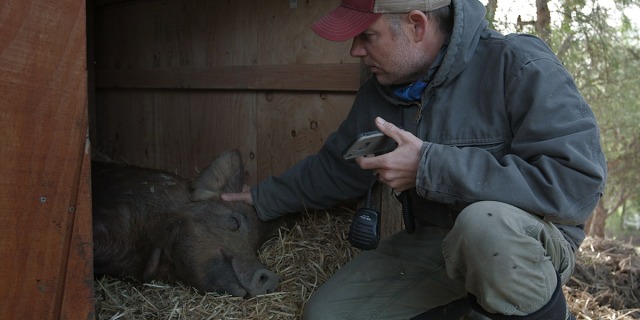
You need to see “The Biggest Little Farm,” and not because that many of us have the energy, gumption and chutzpah to emulate what we see here.
Everybody needs to see this lovely little documentary because of its optimism, a bracing island of hope in a tidal wave of news about the slow motion environmental disaster unfolding around us.
Here’s a movie about the pursuit of balance in nature, the infallibility of biodiversity and the glories of compost.
What cameraman and filmmaker John Chester and chef, blogger and “eat local” advocate Molly Chester did was restore a barren, neglected farm in Moorpark, California, leading by example as they launched an experiment in biology, labor and market-driven farm-to-table capitalism.
And what Chester did was document that with his camera, explaining the changes, reveling in the learning curve and marveling at how land, nature, animals and people can be healed by getting back to the farming we used to know how to do, almost by instinct.
He’s made an informative, inspiring film, joyous in its intimacy, fraught in its various crises, one filled with love, adorable critters, challenges, tragedy and triumph.
In more ways than a mere review can recount, it is the most American movie of 2019, wearing its optimism in every gilded, rain-speckled, sun-flecked frame.
The Chesters were plugging along in their personal and professional lives until the day this rescue dog they took in got them evicted from their Santa Monica apartment.
Their plans to “build a life of purpose together” changed, and Molly led the way. Her “infectious” enthusiasm for food, raised with love and care, and her idealistic notion of a farm, “like something out of a children’s book,” pulled them towards rounding up investors and setting out to launch Apricot Lane Farm, 200 acres that would be tended “in harmony with nature, like a traditional farm from the past.”
Farming has radically changed in the past 150 years, and that created skeptics all around them (quoted, but rarely seen) as the couple took on a foreclosed, arid and dead orchard, with a house on property, surrounded by factory farms.
“Biggest Little Farm” recounts the years it took them to turn it into something that worked. They did some homework, but more importantly, they found themselves a sensei, a guru in this “farming the way it was” ethos.
John narrates the film and his skepticism about this eccentric hippy “back to nature” prophet, Alan York, is evident and repeated, time and again.
York’s “It’ll take care of itself,” like “a flywheel” — self-sustaining so that “it’ll be like surfing” once the place it on its feet, seem delusional, pie-in-the-sky pollyanna-ism.
“Diversify! Diversify! Diversify!” York preaches. There’s “never enough time to do it right, but always enough time to do it over,” if they get something wrong or nature provides unhappy surprises.
But Molly’s all about this sunny York, and John buys in. They put in scores of stone-fruit trees, from peaches to cherries, endless varieties.
They plant “cover crops,” grass and clover, to heal the soil around the trees.
They buy chickens and cows, goats and sheep, to produce revenue but more importantly, to poop.
“Compost was our gold!”
The idea, as pitched by York, was to “emulate how natural ecosystems work,” to let nature find its equilibrium in a farm with a pond for ducks, a house for hens and sheep and cattle grazing amidst the orchards, rebuilding dead soil into something rich and productive.
Worm farming for “compost tea,” putting catfish in their pond, adding herding dogs to help, it all fits together.
Until the predators and “pests” start showing up. The Chesters are tested by snails and starlings, maggots and gophers and worst of all — coyotes, the spree killers of many a henhouse or duck colony.
Chester uses animation and gorgeous natural photography to capture nature returning to this near-desert corner of Southern California. The bees swarm in, and soon all creatures great and small gravitate to their tiny Garden of Eden — gophers to marmots, badgers to bobcats.
There’s a rich tradition, perhaps unique to the United States, in books on this sort of transformation, all harking back to Aldo Leopold’s “A Sand County Almanac.”
Every generation, it seems, has to be re-introduced to this lesson of “letting nature heal” our scarred land, because every generation needs it. Farming has turned industrial, monocultural and chemically dependent.
Maybe the swelling population of the country and the planet demands this scale and efficiency. But maybe there’s another way, “Biggest Little Farm” says.
Granted, not everybody will find the dogged work, sometimes solitary lifestyle and grimmer aspects of dealing with food on such close, life-and-death terms appealing.
And I’d love to see the ledger books on this place, from the investors who got them started to the labor force the Chesters recruit online (“Learn to farm” interns? Volunteers?), which makes one wonder about their actual bottom line.
But “The Biggest Little Farm” is so touching it’ll make you cry, so inviting it’ll make you yearn for something in your life as fulfilling as the healing power of making the barren green, from tiny plots of backyard to a warming and drying planet.

MPAA Rating: PG for mild thematic elements.
Cast: John Chester, Molly Chester
Credits: Directed by John Chester, script by John Chester and Mark Munroe. A Neon release.
Running time: 1:31


